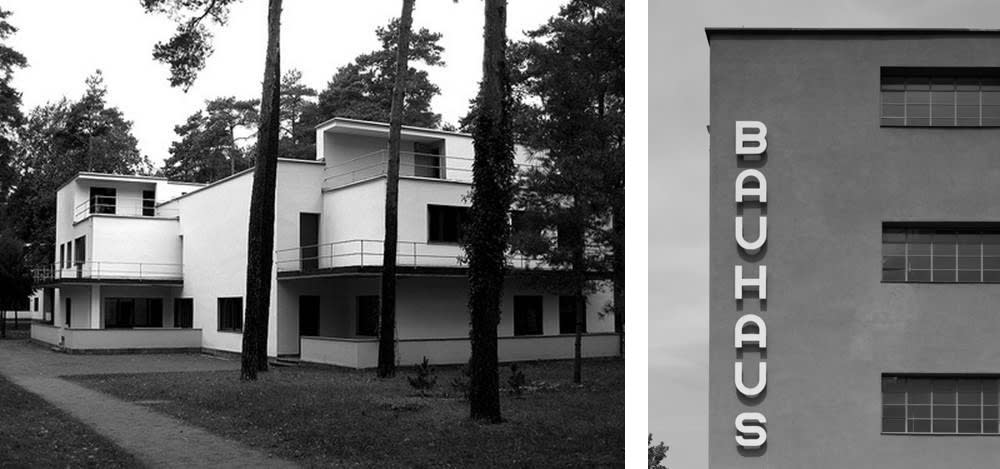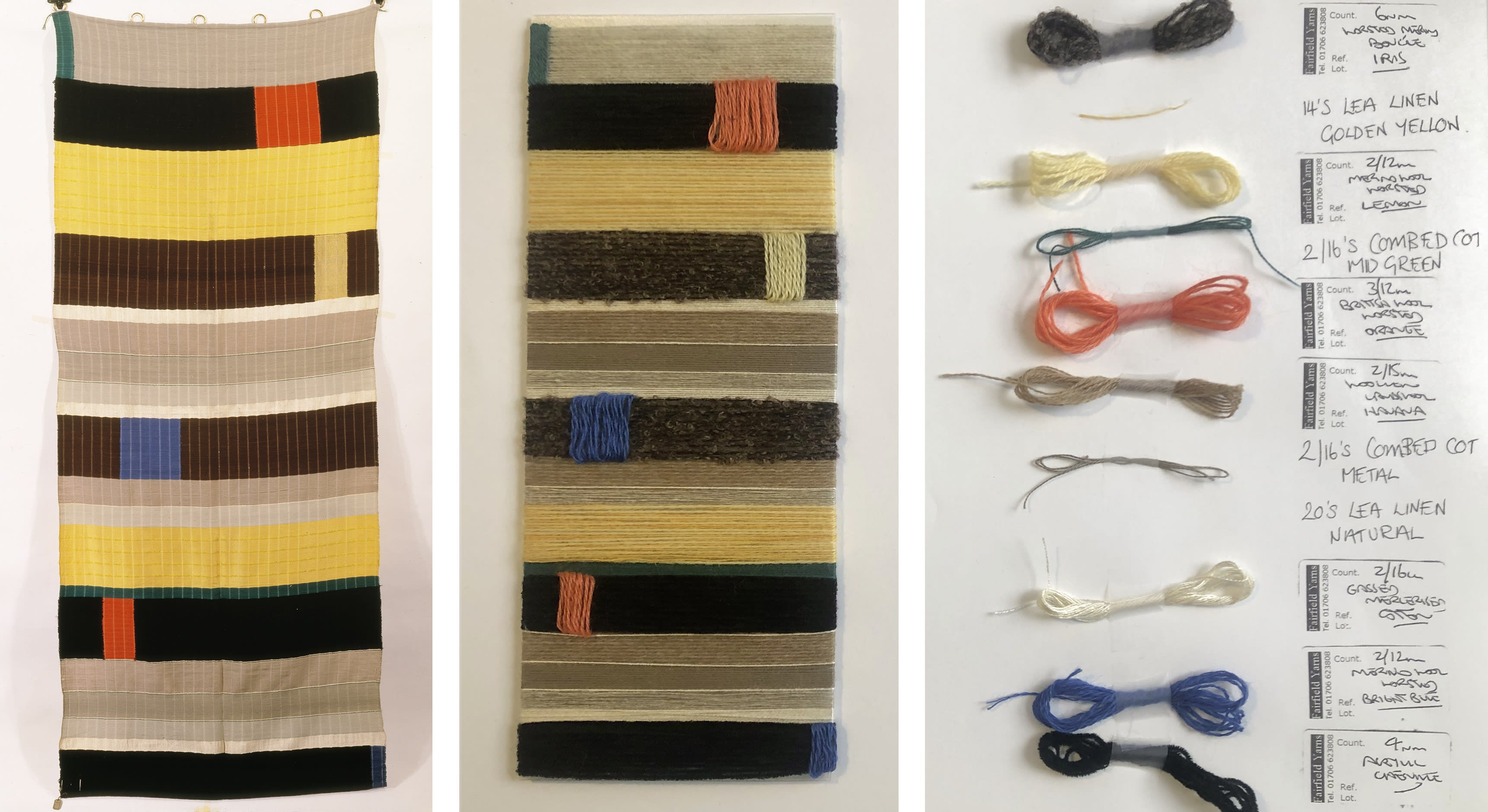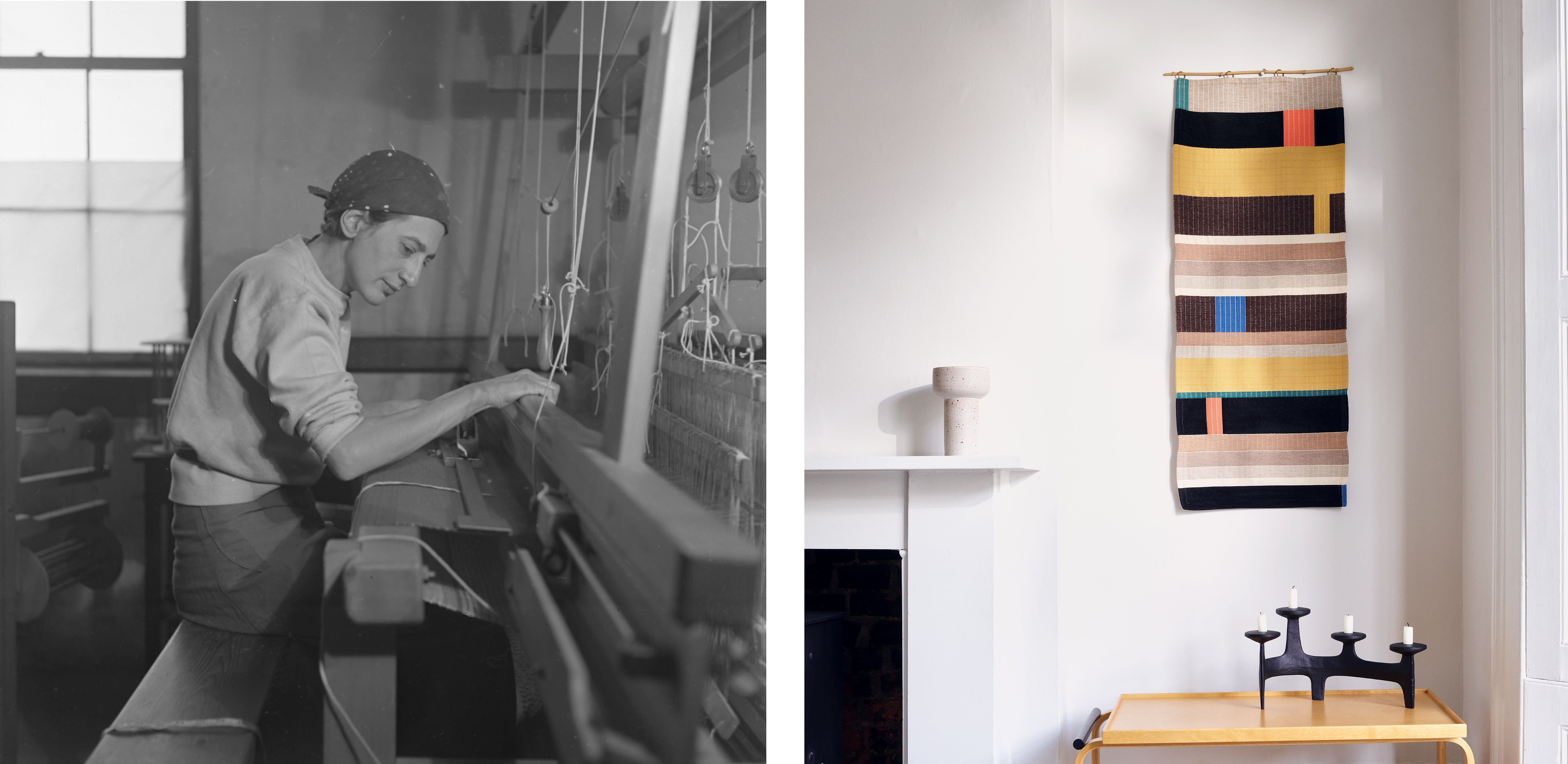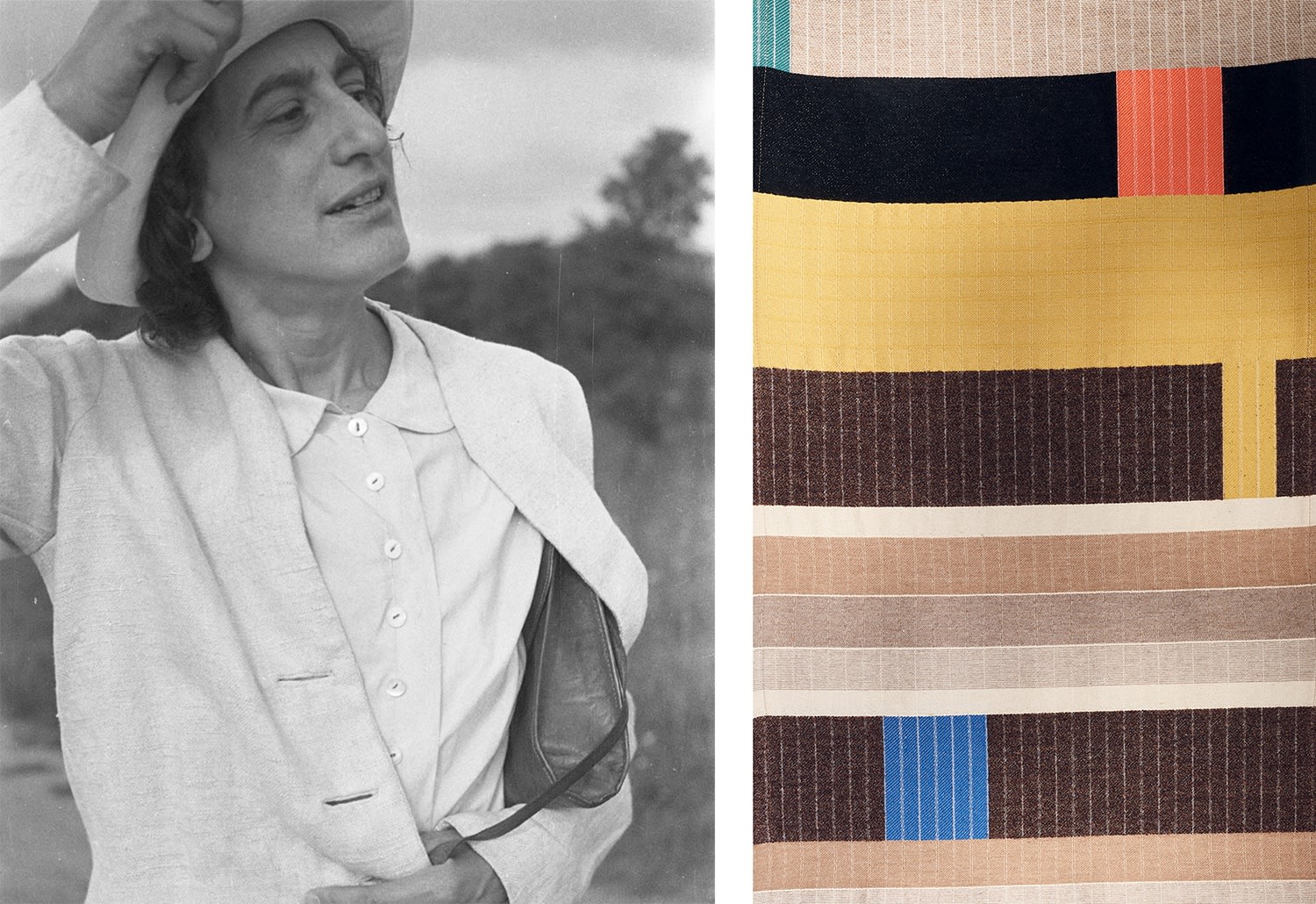-
"Besides surface qualities, such as rough and smooth, dull and shiny, hard and soft, textiles also includes colour, and, as the dominating element, texture, which is the result of the construction of weaves. Like any craft it may end in producing useful objects, or it may rise to the level of art."
— Anni Albers
As part of our ongoing 25th anniversary celebrations, we are honoured to launch a very special anniversary edition - Anni Albers, Wall Hanging 1925/2021. Here we highlight the story behind this creative collaboration between twentytwentyone, The Josef and Anni Albers Foundation and Christopher Farr.
LEFT: Anni Albers, 1929–33, Photo by Josef Albers
© 2021 The Josef and Anni Albers Foundation/Artists Rights Society (ARS), New York -
Wall Hanging 1925/2021
A student at the radical Bauhaus school of art, Anni Albers enrolled in the weaving workshop as many disciplines were not available to women, but this began a life-long passion, textiles becoming her pivotal form of expression. Anni has and continues to be a profound influence on artists and designers the world over, having crafted numerous important small-scale ‘pictorial weavings’ to large wall-hangings and textiles, as well as her later prints and drawings.
Wall Hanging 1925/2021 was created in 1925 – the same year that Anni (then Annelise Elsa Frieda Fleischmann) married Josef Albers and later moved into one of the Bauhaus’ masters’ houses at Dessau.

"Anni Albers avoided defining herself in narrow terms and was constantly innovating and exploring new avenues for creating art. It is wonderful to see her legacy of work continue into new objects such as the creation of this beautiful edition Anni Albers wall hanging, made in collaboration with our wonderful partners at Christopher Farr to celebrate 25 years of twentytwentyone."
– Lucy Swift Weber, Josef and Anni Albers FoundationInspired by the Tate Modern’s landmark Anni Albers exhibition in 2018–19, twentytwentyone rediscovered Wall Hanging 1925 while researching during the first lockdown of 2020. Eager to create a special anniversary edition to mark our 25th birthday, we approached the Christopher Farr team and The Josef and Anni Albers Foundation to explore whether we could collaborate to bring this otherwise inaccessible work to a wider design audience.
The Josef and Anni Albers Foundation has been highly supportive of the project providing a high-resolution scan of the original work which is held in the museum collection of the Die Neue Sammlung in Munich. To recreate Wall Hanging 1925, twentytwentyone and Christopher Farr drew on the expertise of textile design studio Salt.

LEFT: Original Anni Albers, Wallhanging, 1925. Wool, silk, chenille and bouclé yarn – 93 × 373⁄4 in. (236 × 96 cm).
© Die Neue Sammlung, Munich 364.26
MIDDLE + RIGHT: Colour and yarn sampling by Salt.
The impact of lockdown presented an immediate problem, however. With no opportunity to study the original in Munich, the Salt team were obliged to recreate the design from the image provided by the Albers Foundation – which meant they could not see the back of the textile, which often gives valuable clues as to its composition. The weavers had to work intuitively and meticulously, recreating Albers’ design purely from the visual cues from the scan, their own understanding of her approach to hand-weaving, and their material knowledge of the fibres used – cotton, silk, chenille and bouclé. To replicate the colours of the original woven textile, Salt sourced small quantities of old stock yarn from a Yorkshire Mill, fastidiously matching shades to accurately recreate Albers’ extraordinary vision.

LEFT: The industrial loom in progress.
“Anni would have used naturally coloured yarns and dyed her own. It was important to be sympathetic to this, knowing our panel would be a modern representation. The textures also needed replicating – this was the fun part – all from one image. This project was truly made possible because a number of small companies really took the time to get things right. It’s been an honour to see it through to delivery in celebration of 25 years of twentytwentyone. It really is a beautiful piece.”
– June Swindell, SaltLEFT: Anni Albers, near Black Mountain, North Carolina, 1938. Photo by Josef Albers
© 2021 The Josef and Anni Albers Foundation/Artists Rights Society (ARS), New YorkSalt used various weave techniques to reproduce the wall hanging, experimenting with the weft-faced designs to encourage the colour and yarn textures to the surface. Replicating the complexities of the original piece while retaining a visual simplicity and capturing Anni's love of colour was a fundamental starting point.
"It was interesting putting the vertical stripe in as a jacquard pattern as I believe it was just a thicker yarn in the original panel, something that is hard to tell from a picture in a book and an option that was not available to us. We also included double cloth, Anni may have used a woven inlay which is a tapestry technique, I suspect that this is the case from the selvedge’s (sides)."
– June Swindell, SaltThere were many challenges when translating a hand-woven design into one crafted on an industrial loom. The precision of a machine directly contradicts the organic nature of a hand-made object, but most notably the size of the panel was reduced to scale, allowing two to be woven in unison. This, however created further challenges in finishing for the mill, a high level of accurancy was required to replicate the undulating selvedges, rather than the ingrained straight lines.
"..ours is definitely a modern version, which pays homage to the original. Anni embraced industry and mass production, so it was a chance to follow on from that too."
– June Swindell, Salt LEFT: Anni Albers. Photo by Helen Post Modley.
LEFT: Anni Albers. Photo by Helen Post Modley.© Courtesy of Western Regional Archives, State Archives of North Carolina
Due to the translation from hand to machine June and the Salt team focused on capturing the look of the original through the yarn selection, balancing colour, texture and emotive response with technical knowledge.
“It was such an interesting journey exploring the methods of Anni Albers – one of the most influential textile artists of the 20th century. Although there are almost 100 years between the two pieces, it feels poetic that there is a connection that transcends the gap in time through the thread, demonstrating the impact of Anni Albers’ pioneering talent and ability and how it continues to inspire today.”
– Matthew Bourne, Christopher Farr
Q&A
2021 Is anything known about the original Wall hanging 1925 in terms of its creation, influences and provenance prior to becoming part of the collection at the Die Neue Sammlung in Munich?
Lucy Swift Weber Anni created this weaving at the weimar Bauhaus just at a period when Anni was exploring asymmetry in her weavings and it was acquired by the innovative Ludwig Grote, who was very partial to modernism, for the Die Neue Sammlung.2021 It is written that the Bauhaus’ founder Walter Gropius at the time advised female students against study in heavy crafts such wood, metal and glass – suggesting textiles or pottery instead – it’s hard to imagine Anni Albers not working in textiles but is there any evidence that suggests she may have taken a different path if the Bauhaus had encouraged participation in other mediums?
Lucy Swift Weber She considered wall hanging but had physical issues that prevented her from being able to get on a ladder. She did not do metal work but she did make the brass wings for the angel that flew over the Bauhaus for a birthday celebration of one of her favorite teachers, Paul Klee.
2021 The Tate exhibition of Anni Albers in 2018-19 was incredibly inspiring and sparked the idea for this collaboration. Has this important retrospective had an impact in terms of the Foundation’s work?
Lucy Swift Weber The Tate exhibition increased public familiarity with Anni’s work. It was a wonderful exhibition and the public response to it has been exciting to behold.
2021 Will the exhibition travel or be available in other museums in the future?
Lucy Swift Weber No. That exhibition originated in Dusseldorf and ended at Tate. We do have a very exciting exhibition opening in Paris at the Musee D’Art Moderne, in September.
2021 The Foundation is also celebrating an anniversary in 2021 – 50 years – congratulations! Do you have any events planned to mark this landmark?
Lucy Swift Weber The exhibition in Paris will be unlike anything that has come before and will feature a large and diverse selection of art by both of the Albers. We are also creating a fabulous new book, with the help of the great design team, Graphic Thought Facility, to celebrate 50 years of The Albers Foundation. We will also be introducing a new visual identity for the Foundation and our sibling organizations and at some-point in the relatively near future, we will be launching an entirely new website.
Released as a numbered edition, the piece is available to buy exclusively at twentytwentyone’s London shop, showroom and www.twentytwentyone.com, priced at £650.
-
Anni Albers Wall Hanging, 1925/2021
Numbered edition
£650


